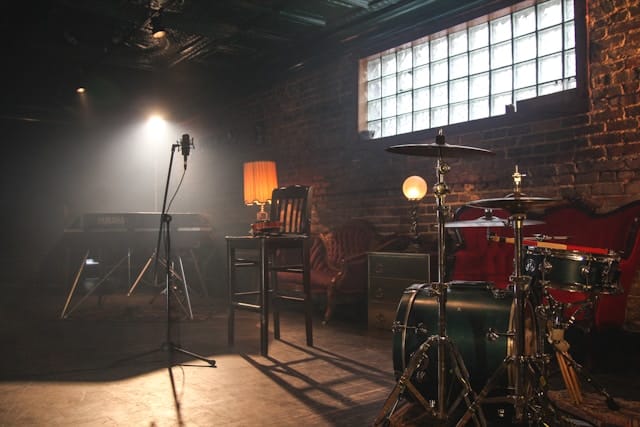The basement studio in your house is a space of boundless creative potential. However, one challenge you might face is how to use lighting to create a hospitable and inspiring environment. Given the lack of natural light in these subterranean spaces, it’s important to understand how to best utilize all available light sources. Here are some best practices to maximize daylight in your basement studio.
Optimize Your Window Placement
The strategic placement of windows is crucial in maximizing daylight in your basement studio. The windows provide not only a source of natural light but also a visual connection with the world outside.
En parallèle : What’s the Most Effective Method to Create a Non-Slippery Tile Floor in a Wet Room?
The key is to identify where the sun will be during the times you’ll be using the studio most. This will allow you to make the most of the natural daylight filtering through. The orientation of your house can also play a big role in determining the best places for window installation.
Windows placed higher up on the wall will also allow more light in, as the light can travel further into the room. You should also consider the size of the windows. Larger windows will allow more light in, but may also bring in more heat and could potentially compromise your privacy.
Dans le meme genre : How Can You Create a Cost-Effective Soundproof Podcasting Room at Home?
When considering window design, think about using glass with high light transmittance. Clear glass is typically the best option as it allows the most light in. However, if privacy is a concern, you can opt for frosted or tinted glass, which will still allow a good amount of light in while preserving your privacy.
Use Reflective Surfaces to Distribute Light
The use of reflective surfaces is another effective way to maximize daylight in your basement studio. Light, when it hits a reflective surface, bounces off and spreads further into the room. This allows the space to be lit more evenly and reduces the odds of having dark corners.
One very effective method to implement this is by using mirrors. Strategically placed mirrors will reflect light into darker areas of the room, helping to brighten the space. You might even consider installing a large mirror on a wall opposite a window to reflect more light.
Additionally, consider the colors in your studio. Lighter colors tend to reflect light better than darker ones. Hence, painting your walls a light color will help bounce light around the room. The same principle applies to your furniture. Opt for furniture with lighter or reflective surfaces to help distribute light around the room.
On the floor, using a light-colored or reflective floor covering can also help reflect light into the space. Consider materials like light wood, white tiles, or polished concrete for your floor.
Install Proper Artificial Lighting
While maximizing daylight is key, don’t forget about the importance of artificial lighting in your basement studio. After all, you won’t always be working during the day, and even during daylight hours, the natural light may not always be sufficient.
A combination of different lamps can be used to provide a balanced lighting scheme. Task lighting, such as desk lamps or pendant lamps, can provide focused light where you need it most, while ambient lighting, like ceiling lights, can help to illuminate the entire room.
Consider using lights that mimic natural daylight. These can help to regulate your circadian rhythm, which can be disrupted if you’re spending long hours in a basement studio with little exposure to natural light.
Don’t forget about the color temperature of your lights. Cooler, bluer lights can help to mimic daylight and can be beneficial if you’re working in the studio during the day. On the other hand, warmer, yellower lights can help to create a cozy atmosphere if you’re working in the evening.
Select the Right Window Coverings
The type of window coverings you choose can also have a significant impact on the amount of daylight in your basement studio. While it’s important to maintain your privacy, you also want to let in as much light as possible.
Consider using blinds or shades that can be easily adjusted to control the amount of light coming into the room. These can be tilted to direct the light onto the ceiling, helping to distribute it throughout the room. Light-colored or reflective blinds or shades can also help to maximize the amount of light in the room.
If you prefer curtains, opt for light-colored, sheer fabrics that allow light to filter through even when they’re closed. Avoid heavy, dark curtains that can block out a significant amount of light.
Incorporate Daylighting Strategies into Your Design
Last but not least, consider daylighting strategies when designing your basement studio. Daylighting is the practice of placing windows, or other transparent materials, and reflective surfaces in a space to allow daylight to provide effective internal lighting.
Daylighting strategies can help to maximally utilize the natural light available throughout the day. For instance, you might want to incorporate a sun tunnel or a skylight into your design. Sun tunnels or tubular daylight devices capture daylight at the roof, transport it down a reflective tube, and distribute it into your space. Skylights, on the other hand, provide a direct connection to the sky, which can make a space feel brighter and more open.
Remember, the goal is not only to increase the amount of daylight in your basement studio but also to distribute it effectively throughout the space. By taking the time to consider your lighting, you can create a bright and inviting basement studio that is perfect for your creative endeavors.
Implement Energy Efficient Lighting Solutions
As you strive to maximize daylight in your basement studio, it’s crucial to consider the energy efficiency of your lighting solutions. This isn’t only about saving on your energy bills, but it’s also about ensuring that your studio is eco-friendly.
Your goal should be to optimize the use of natural light during the day and complement it with energy-efficient artificial lights. Always look for energy-saving bulbs for your wall lights, ceiling lights, table lamps, floor lamps, or any other light sources you may have in your studio. LED lights can be a perfect choice since they consume less power and have a longer lifespan compared to traditional incandescent bulbs.
Also, consider the use of light controls like dimmers, timers, or motion sensors in your basement studio. This aids in energy efficiency as they ensure lights are only on when required, thus preventing wasteful energy consumption.
Moreover, when planning your house or studio renovations, integrate daylighting strategies into your house plans. You can collaborate with a project management specialist or an interior designer who understands eco-friendly designs. This will ensure the best utilization of natural light without compromising on energy efficiency.
Utilize Circadian Lighting for Health and Productivity
When thinking about the lighting of your basement studio, it’s important not to overlook the impact of light on your health and productivity. This is where circadian lighting comes in.
Circadian lighting mimics the natural progression of the sun, providing cooler, bluer light in the morning shifting towards warmer, softer light in the evening. This type of lighting can help regulate your body’s natural sleep-wake cycle, or circadian rhythm, which can be disrupted if you’re spending long hours in a basement studio with little exposure to natural light.
A well-designed circadian lighting system can help to enhance your mood, increase your concentration levels, and improve your overall well-being. For instance, having cooler, brighter daylight in your studio during morning hours can help to kickstart your day, keeping you alert and focused. As the day progresses, shifting to warmer, softer lighting can signal your body that it’s time to wind down, helping to promote relaxation and better sleep.
Conclusion
Maximizing daylight in your basement studio can transform it from a dark room into a bright, vibrant workspace that inspires creativity. The goal is to find a balance between natural and artificial lighting that suits your needs and preferences. By strategically placing windows, selecting appropriate window coverings, utilizing reflective surfaces, and implementing energy-efficient and circadian lighting, you can create a pleasant lighting environment in your studio.
Don’t limit yourself to living room or dining room spaces when looking for inspiration. Lighting solutions for these spaces, such as chandeliers, pendant lights, or outdoor lighting, can also be adapted to a basement studio.
The path to a well-lit basement studio doesn’t have to be overwhelming or expensive. With careful planning, you can optimize your studio’s lighting situation, helping to create a space where creativity thrives. Remember, every light source counts, and even the smallest changes can make a big difference. Embrace the challenge and let your creativity shine in your well-lit basement studio.











